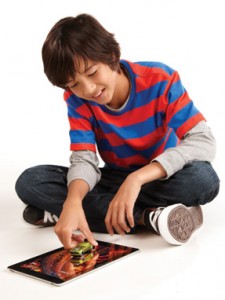In recent years, augmented reality (AR) toys have gained increasing prominence at the International Toy Fair held in New York. Many of the industry’s biggest players have launched AR lines: Mattel’s Apptivity products build upon the strength of existing brands such as Batman and Hot Wheels; Hasbro’s Lazer Tag works with a compatible app to insert digital targets into the user’s environment; and the toys in Disney’s DreamPlay line, launching in the U.S. this fall, will enable kids to play along on musical instruments with digital versions of popular Disney characters.

But what is augmented reality? Broadly speaking, the term augmented reality describes technology capable of producing digital content to enhance a user’s physical experience. In contrast to virtual reality, which draws users into a virtual world, augmented reality brings digital content out into the physical world. Using technology such as image recognition with a camera, GPS, and the built-in accelerometers in many devices, the digital content generated is rendered in real time, dynamically changing in response to the user’s actions. In one iteration, then, AR creates a layer of digital content that can be overlaid across the user’s field of vision, for example, the Barbie Digital Makeover Mirror, which lets kids try on makeup virtually. Conversely, augmented reality can generate virtual spaces with which a user interacts, such as the Sesame Street playset prototype (created in collaboration with Qualcomm a couple of years ago) or Apptivity Hot Wheels cars, which drive across dynamically rendered roads on an iPad screen, prompting the user to physically navigate their car through a virtual environment.
Augmented reality represents huge possibilities for the toy industry. These toys permit toymakers to design relatively inexpensive products that utilize mobile devices and smartphones—more expensive technologies—that many users already have, and they extend the market for tech toys to ever younger audiences. Fisher-Price’s Laugh and Learn Apptivity line, for example, features products such as iPhone and iPad cases, and the Laugh and Learn Apptivity Monkey and Puppy, two interactive plush toys that come to life with an iPhone clicked into their stomach, all designed for children ages 6 through 36 months. Like traditional playsets, augmented reality toys also facilitate repeated purchases, as in the case with Wowee’s AR game Zombie Burbz, or Apptivity’s Batman, in which additional levels are unlocked with the purchase of additional figures.
Is the kind of play that AR toys facilitate active or reactive? How do AR toys encourage free and directed play, and how do they aid or promote play differently than their traditional counterparts? Does “unlocking” different experiences feel like puzzle-solving or like instilling an insatiable appetite for novelty, of seeing what the toy can do next or what else it does to win the user’s attention? In what ways does AR supplement, guide, encroach upon, or otherwise engage a child’s imagination? Overlaying digital content on a real environment can prove instructional, entertaining, or seem magical, but is there a converse concern that the insertion of screen-based content between a user and the world around them unnecessarily filters or focalizes the user’s perspective?
Apps that overlay information on the user’s spatial environment can make history and geography come alive. Products like Ravensburger jigsaw puzzles and Popar 3D picture books bring characters and settings to life, as well. In fact, the notion of bringing things to life, of liveliness and animism, are among the most commonly used means of describing what augmented reality does. All of which raises the question of what it means to bring toys to life, and how play is different when a particular technology is seen as achieving that goal. Were toys dead before? If they were alive, what made them so? (It strikes me that battery-operated toys might be regarded similarly). How do children’s play experiences change with the expectation that something is making their toys come alive?
As we know, new technology is frequently polarizing, particularly when it comes to how it is introduced to and adopted by children. Rather than placing AR on any specific point along this continuum of promises and perils (indeed, its varied applications could be plotted across such a spectrum), I am interested to watch as this nascent category of playthings continues to develop and how these critical questions play out.
Especially while these toys are still novelties and companies are clamoring to get them onto the market, I would love to hear from readers who have observed children with AR toys, in either informal or research and development settings, from educators who have or hope to incorporate AR into their pedagogical practices, and developers as they consider the behaviors of young users in the design of new applications.
Watch for a future post on AR and its potential for education.
 Meredith A. Bak is a Visiting Assistant Professor of Film and Media Studies at Franklin & Marshall College in Lancaster, PA. Her research interests include media archaeology and the intersection of “old” and “new” media, particularly in relation to children’s media and material culture. Her current project focuses on how pre-cinematic visual media like early pop-up books and optical illusion toys helped cultivate children as media spectators near the turn of the twentieth century. A second project on augmented reality toys in development. Before completing her PhD, Meredith worked in museum education at the Museum of the Moving Image in New York, and as a teaching artist in public schools for the Urban Arts Partnership, instructing in the areas of animation, video production, and game design.
Meredith A. Bak is a Visiting Assistant Professor of Film and Media Studies at Franklin & Marshall College in Lancaster, PA. Her research interests include media archaeology and the intersection of “old” and “new” media, particularly in relation to children’s media and material culture. Her current project focuses on how pre-cinematic visual media like early pop-up books and optical illusion toys helped cultivate children as media spectators near the turn of the twentieth century. A second project on augmented reality toys in development. Before completing her PhD, Meredith worked in museum education at the Museum of the Moving Image in New York, and as a teaching artist in public schools for the Urban Arts Partnership, instructing in the areas of animation, video production, and game design.
Twitter: @meredith_bak

